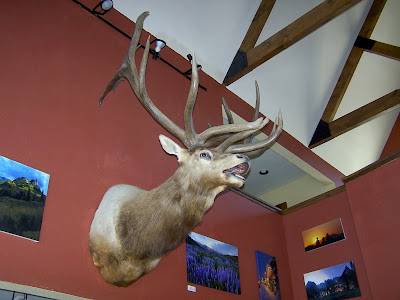First off, a little geology lesson! According to some of the signs placed along the path near town, Crested Butte* is something called a laccolith. As you can see on the diagrams below on the sign, laccoliths look kind of like pimples that form at some places on the earth's surface. First, layers of sedimentary rock were deposited. Next, igneous rock in the form of magma melted its way through several of the underlying sedimentary layers, as you can see in the second picture. The presence of more matter caused the overlying sedimentary layers to be pushed up, while the underlying layers remained flat.
Over time, the magma cooled and crystallized, forming a granite-like igneous rock, with crystals of feldspar mixed in. By using radiometric dating, geologists have determined that these rocks were formed around 30 million years ago, during the Oligocene Epoch. Over those last 30 MY, erosion and weathering have broken down those layers of sedimentary rock that once covered the laccolith, and exposed the intrusion. The intrusion is what makes up what you would walk on and see when you are on the mountain.
 |
| A picture of some of the rocks near the summit of Crested Butte. You can see a little pika peeking out from behind a rock in the center of the picture! Interestingly (at least to me), the last time I talked about either pikas or the Oligocene Epoch was in the same post, the "Top Ten Mammals That Look Like Something They Aren't (Part 1)," a fun post if there ever was one! |
Crested Butte (the mountain) has been further isolated from the surrounding mountains due to the influence of glacial forces. Telltale signs of past glaciation are abundant in and around Crested Butte, including the u-shaped valleys, polished bedrock, giant boulders in places where they have no business being, and moraines (defined below), amongst other lines of evidence, all point to past episodes of glaciation. Geologists have dated most of the moraines as about 22.5 to 16.5 thousand years old, during the last Ice Age, and believe that glacial retreat occurred rapidly about 15,000 years ago. Even older glacial deposits date back to around 100,000 years ago!
The scenery was truly spectacular between the town and where we were staying, up near the mountain resort, which in turn was next to the very confusing home rule principality of Mt. Crested Butte. At times, the path turned into a boardwalk, which helped to preserve the wetlands in the area.
Towards town, we passed over the Slate River.
A shot of the bridge over the Slate River in the foreground, with Crested Butte in the background.
As you can imagine, the area was populated by numerous birds, several of which I got pictures of. I am fairly confident that this first one was a female mountain bluebird (Sialia currucoides).
We also saw a ton of killdeer (Charadrius vociferus), a fascinating bird, the adults of which will feign injury to draw predators away from fledlings, nests, eggs, and the like. I've included a video which shows one of these animals doing its injury feigning! In case the internal link or whatever it's called isn't working, click HERE to view the video.
Here are the pictures I took of the many killdeer running around!
A few more shots of the amazing scenery!
The next day out the window of the hotel room, we saw a pudgy dog walking by with a neck pillow looking thing around its neck. A little research revealed that this was a KONG Cloud E-Collar, which pretty much serves the same purpose as the cone that you put on dogs and cats after surgeries or the like.
Here is another picture of the dog. This time it is relieving itself.
We ate breakfast at a fun little place along the creek! I had a pancake that was ridiculously enormous.

There were lots of very pretty flowers all over town, including these yellow or wood poppies (Stylophorum diphyllum).
I don't remember which building it was exactly, but one of the buildings in town had the mounted head of what is supposedly the world's largest rack of elk antlers, shot in Crested Butte in 1899 by a man named John Plute. The antlers were certified as the largest in the world in 1961. They definitely did look pretty large!

We'll be looking at more pictures from Crested Butte later! See you then!
*Point of interest and possible confusion: Crested Butte can refer both to the town with a population of around 1,000, or the mountain with an elevation of 12,168 feet. If you hear someone talk about Mt. Crested Butte, then they are most likely referring to the home rule principality by that name. I don't really know what a home rule principality is, and a little bit of research nearly put me into a deep, trance-like state.
Works Cited:






































